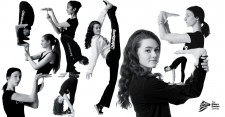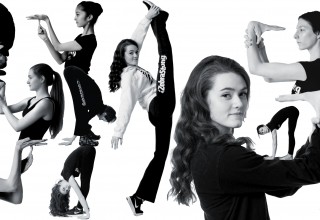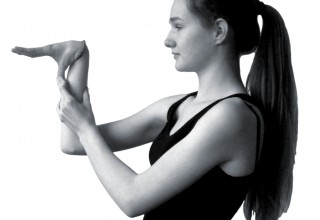Born This Way? When Hypermobility Has Its Privileges - and Problems

BALTIMORE, May 23, 2018 (Newswire.com) - For gymnasts, dancers, acrobats, and skaters, being graced with natural hypermobility can be a tremendous blessing — until it isn’t — especially for those born with hypermobile Ehlers-Danlos (hEDS) or one the hypermobility spectrum disorders (HSD). As part of Ehlers-Danlos Awareness Month 2018, The Ehlers-Danlos Society is raising awareness about hypermobility within the dance, gymnastics, and acrobatic communities — and help families understand the challenges hypermobility may present.
“My dance teacher loved me because of my flexibility,” recalls Kate Schultz, a former dancer from Wisconsin living with hypermobile Ehlers-Danlos syndrome. “I could slide down into the splits without realizing anyone else struggled. I could stretch and contort my legs in more complex pretzels than anyone else in my classes. As I’ve gotten older, the flexibility has turned into instability. Joints that did me favors by being loose when I was younger are now unable to stay where they belong and are a detriment to my well-being.”
Joints that did me favors by being loose when I was younger are now unable to stay where they belong and are a detriment to my well-being.
Kate Schultz, Former Dancer
Joint hypermobility, one of the most prevalent symptoms across multiple types of Ehlers-Danlos syndromes (EDS) and hypermobility spectrum disorders (HSD) can be advantageous in certain sports and activities. And researchers have observed a high prevalence of joint hypermobility among dancers and gymnasts. (Briggs, et al. 2009)
THE COST OF EARLY COMPETITIVE ADVANTAGE
However, hypermobility can sometimes come at a cost. From susceptibility to injuries to myriad related health challenges, those living with Ehlers-Danlos or hypermobility spectrum disorders are likely to face considerable challenges as they reach for most elite levels of ballet, gymnastics, and other athletic endeavors where flexibility is seen as a competitive advantage (Briggs, et al. 2009).
Hypermobility is often seen as advantageous for these athletes, literally giving dancers, gymnasts, acrobats, and skaters a “leg up” on their competition. However, the early advantages may quickly become challenges, as serious joint hypermobility may lead to joint instability, frequent dislocations, chronic pain — and a whole host of EDS/HSD symptoms and related conditions. Indeed, recent research demonstrates that hypermobile athletes may become injured more often — and took longer to heal, too often preventing advancement or leading to early retirement (Schmidt, et al. 2017).
UNDER-DIAGNOSIS OFTEN LEADS INJURY
At the same time, because EDS and HSD are underdiagnosed — both in the general population and these communities — dancers, gymnasts, and acrobats born with extreme hypermobility often face a dual challenge. They may need medical care more often while finding few physicians, trainers, and coaches adequately trained to treat, or even evaluate their injured athletes for hypermobility (McCormack, 2010).
“Before my diagnosis, my doctors all l assumed that I was hypermobile because I was a competitive gymnast,” says Jessica Adelman, a disability advocate and social media manager. “It never occurred to any of them that I was a gymnast because I was naturally hypermobile. As a result, my hypermobility was dismissed as irrelevant, and it took 11 years and 18 doctors to finally receive my hEDS diagnosis. By then, my gymnastics career was over.”
EARLY DIAGNOSIS IS CRITICAL TO INJURY PREVENTION
For these athletes, diagnosis can be the key to finding appropriate management. Physical therapy can help develop a strengthening and stabilizing program to protect the joints. Careful postural and alignment instruction can train the athlete to alter each movement to lessen strain and prevent injury. Informed physicians can help navigate any other complications, such as pain and fatigue (McCormack, 2010).
“The hypermobile body has a number of challenges but also some valuable advantages. Line and flexibility can be truly displayed once strength, stability, and coordination have been acquired. In dance, different body types will require a different emphasis in training. Understanding the hypermobile body means you can train with realistic aims.” — Moira McCormack, the chief Physiotherapist for the Royal Ballet Company in London, England (McCormack, 2014).
“For us, early diagnosis was absolutely critical to our son’s health,” states Peter, the father of a teen who trained at The School of American Ballet and school of The American Ballet Theatre. “Because his knees were prone to extreme hyperextension from the earliest age, we sought to strengthen his legs without putting too much pressure on his knees. By reaching out to his teachers, and making his hyperextension known from the beginning, he not only avoided knee injuries, he grew in strength. And, the confidence he gained from excelling in dance actually improved his school work.”
AWARENESS MATTERS: THE EHLERS-DANLOS SOCIETY REACHES OUT
To grow awareness and facilitate better communications between families, coaches, and teachers, The Ehlers-Danlos Society is excited to launch a global awareness initiative to educate athletes, instructors, physicians, and trainers in the dance, gymnastics, and acrobatic communities about EDS and HSD.
“Everyone involved in dance and gymnastics should know about EDS and HSD,” said Lara Bloom, International Executive Director of The Ehlers-Danlos Society. “If instructors and trainers are able to recognize the signs of these conditions, more of these athletes can receive appropriate care, which can reduce injuries, prolong careers, and ease pain.”
WHAT YOU CAN DO
Help spread awareness among the dance, gymnastics, acrobatic, and other hypermobility intensive communities!
Learn more about the Ehlers-Danlos syndromes, hypermobility spectrum disorders, and Assessing Joint Hypermobility.
- Tell your friends in the dance, gymnastics, and acrobatics world about EDS and HSD
- Post about EDS and HSD on social media
- Reach out to schools, gyms, and studios and offer awareness posters and brochures
- Tell us about your experiences with EDS/HSD and dance, gymnastics, or acrobatics
Know More: Additional Readings
Briggs, J., Mccormack, M., Hakim, A. J., & Grahame, R. (2009). Injury and joint hypermobility syndrome in ballet dancers--a 5-year follow-up. Rheumatology,48(12), 1613-1614. doi:10.1093/rheumatology/kep175
McCormack, M. (2010). Teaching the Hypermobile Dancer. International Association for Dance Medicine & Science,2(1), 5-8.
McCormack, M. (2014, July 21). The Hypermobile Dancer. Retrieved from http://www.4dancers.org/2014/07/the-hypermobile-dancer
Schmidt, H., Pedersen, T. L., Junge, T., Engelbert, R., & Juul-Kristensen, B. (2017). Hypermobility in Adolescent Athletes: Pain, Functional Ability, Quality of Life, and Musculoskeletal Injuries. Journal of Orthopaedic & Sports Physical Therapy,47(10), 792-800. doi:10.2519/jospt.2017.7682
Source: The Ehlers-Danlos Society




